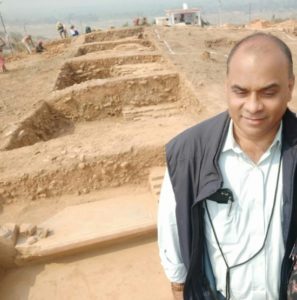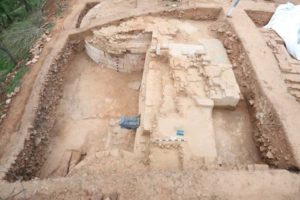Change font size -A A +A ++A

Nunnery with three layers of bastions.
Our Bureau/
Second phase of excavation works at ancient Krimila (Lakhisarai), the erstwhile power center and also an important Buddhist center in India during Pala dynasty, exposed unique wonder for history lovers and archaeologists.
The Nunnery (monastery for Buddha Vikchnis-nuns) which had been excavated at Lalipahari, Jaynagar inside Lakhisarai township last year, was surrounded by three bastion on each corners as suggested by the recent findings of three layers of security covers of the Nunnery.

Prof. Anil Kumar at Lali Pahari excavation site.
According to Prof. Anil Kumar, a senior teacher of faculty of history at Visva Bharati University and the team leader of Lali Pahari excavation, after finding of three bastions on each corners (two sides), it is believed that the four sides of the Nunnery was surrounded by three layers security covers. “We have strong believe that we will get another six bastions on two sides like the six till now from another two sides,” Prof. Kumar hopefully explained.
According to him, central bastion of the corner is 75 feet in diameter. On every six meters of distance all the three is located. “We so far recovered six such bastions after excavating two corners, north east and south east, so far. Hope we will expose such bastions from two other sides too,” he told news5pm team.
It was indeed a unique monastery having three bastions on each corner, when Vikramshila Buddha Mahavihara has just one bastion on each four of the corners in the entire structures excavated at Anti Chak in Bhagalpur district, Prof Kumar pointed out. “This is first time in the world when a monastery has been found having three bastions. I hope since it was a Nunnery for the Buddhist Vikchnis (nuns), the than management of this monastery, ie, the Pala kings might had left no chance for security lapses for the nuns and were very much sensitives towards the safety and security of women ,” he claimed.

Makar Pranal (black part) inside the half-excavated Nunnery site.
Giving references of the perfect managements especially for the promotion of religious, education along with art and culture by the Pala rulers, Prof Kumar claimed that such types of security arrangement for this Nunnery once established how the management of this Nunnery was careful towards the issues related to women. He also hoped that in coming days more such instances would be reveled from the ongoing excavation.
It is pertinent to note here that earlier Prof Kumar’s team found ‘Makar Pranal’ , the outlet of water through a drain which was built in very artistic manner at the Nunnery. “There were toilets and bathrooms for the Vikchunis inside this Nunnery as existence of this ‘Makar Pranal’ suggested. We have found the portion of kitchen inside this campus and water from all such parts drained out in a systematic way. It also shows that at that time, the occupants of this Nunnery need not had to venture out side for finishing such important parts in daily life routines,” said some team members of Prof. Kumar.

Excavation works are on progress at Lakhisarai.
“The recent finding of such bastions mainly for security reasons to a monastery where Buddhist Vikchnis (nuns) were living in numbers, really shows how the Pala rulers were serious about women folks and also their ideas for providing protection to the Nunnery . This excavation is very important for establishing many such unique events of that period,” Siv Shanker Singh Parijat and Prof Raman Sinha, Bhagalpur based historians also echoed Prof. Kumar’s observations.



Leave a Reply